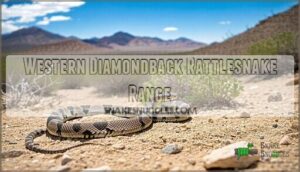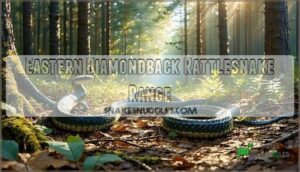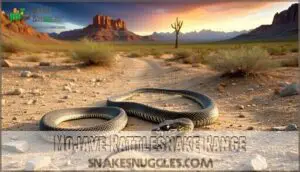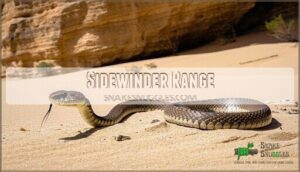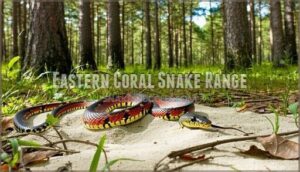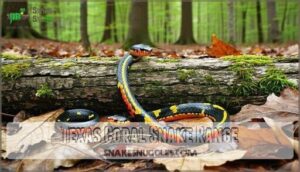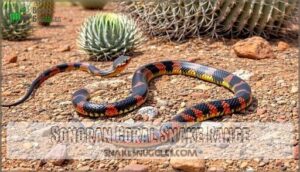This site is supported by our readers. We may earn a commission, at no cost to you, if you purchase through links.
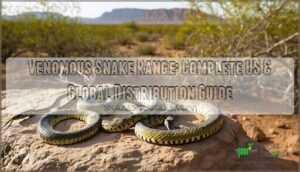
The four main players—rattlesnakes, cottonmouths, copperheads, and coral snakes—each claim their own turf based on climate and habitat preferences.
Rattlesnakes dominate the show with the widest distribution, thriving everywhere from Arizona’s scorching deserts to North Carolina’s humid forests.
Cottonmouths stick to southeastern wetlands, while copperheads master eastern woodlands with their leaf-mimicking camouflage. Coral snakes prefer sandy soils and woodland hideaways.
Geography, temperature, and prey availability shape these patterns, creating hotspots where multiple species overlap and safe zones completely free of venomous threats.
Table Of Contents
- Key Takeaways
- Venomous Snakes in The US
- Rattlesnake Distribution
- Cottonmouth and Copperhead Range
- Coral Snake Range
- States With No Venomous Snakes
- Venomous Snake Range by State
- Global Venomous Snake Range
- The Big 4 Deadliest Snakes
- Venomous Snake Safety
- Venomous Snake Conservation
- Frequently Asked Questions (FAQs)
- Where are venomous snakes found in the US?
- How far north do venomous snakes live?
- What 3 states have no venomous snakes?
- Where is the deadliest snake on earth found?
- What is the average lifespan of venomous snakes in the wild?
- How do venomous snakes adapt to different climate regions?
- What factors influence the population size of venomous snakes?
- What are the conservation efforts for endangered venomous snake species?
- How far do venomous snakes travel daily?
- What elevation limits affect venomous snake distribution?
- Conclusion
Key Takeaways
- You’ll encounter venomous snakes in 46 states – only Alaska, Hawaii, Maine, and Rhode Island are completely snake-free, so you need to stay alert in nearly every other state you visit.
- Rattlesnakes have the widest distribution across America, from Arizona’s deserts to North Carolina’s forests, making them the most likely venomous snake you’ll encounter during outdoor activities.
- Geography determines which species you’ll face – cottonmouths stick to southeastern wetlands, copperheads dominate eastern woodlands, and coral snakes prefer sandy soils in southern states.
- Prevention beats treatment every time – wear boots, watch where you step, make noise while hiking, and learn basic identification features like triangular heads and heat-sensing pits to avoid dangerous encounters.
Venomous Snakes in The US
You’ll encounter four main types of venomous snakes across the United States: rattlesnakes, cottonmouths, copperheads, and coral snakes.
Each species has adapted to specific habitats and regions, from desert rattlesnakes in the Southwest to water-loving cottonmouths in southeastern swamps.
Rattlesnakes in The US
When you encounter rattlesnakes across America, you’re meeting the continent’s most widespread venomous snakes.
These remarkable predators inhabit diverse environments from desert floors to mountain forests. Western Diamondback Rattlesnakes dominate southwestern landscapes, while Timber Rattlesnakes prefer eastern woodlands. Eastern Diamondback Rattlesnakes reign as giants in southeastern pine forests.
From scorching deserts to misty mountains, America’s venomous serpents rule diverse kingdoms with deadly precision
Their venom effects vary by species, but all pack a serious punch. Conservation status remains stable for most populations, though habitat loss threatens some.
These efficient hunters primarily target rodents, helping control pest populations naturally, which is a key aspect of their role in the ecosystem, making them important for maintaining ecological balance, and thus, their presence has a significant conservation impact.
Cottonmouths in The US
You’ll find cottonmouths in southeastern US wetlands, where these aggressive species thrive near water.
Eastern Cottonmouth and Florida Cottonmouth populations dominate swamps, marshes, and slow streams.
Their cottonmouth habitat preferences make them excellent swimmers, hunting fish and frogs.
Unlike typical water snakes, cottonmouths deliver potent hemotoxic venom effects through defensive strikes.
Understanding snake behavior helps identify these dangerous venomous snake range occupants in their preferred snake habitats.
Copperheads in The US
Copperheads rank as the most common venomous snake you’ll bump into across the eastern United States. These pit vipers pack a nasty but rarely fatal punch.
These eastern pit vipers deliver America’s most common venomous bite
- Eastern Copperhead: Found throughout deciduous forests from Massachusetts to Alabama, sporting distinctive hourglass patterns
- Broad-banded Copperhead: Prefers oak and cedar woodlands with wider, darker bands than their eastern cousins
- Snake Behavior: Masters of camouflage who freeze when threatened, relying on leaf-litter disguise rather than fleeing
- Venom Effects: Causes severe pain, swelling, and tissue damage but death rates remain extremely low
- Copperhead Diet: Ambush predators targeting rodents, frogs, birds, and large insects using heat-sensing pits
Coral Snakes in The US
Two highly venomous coral snakes inhabit the US: the Eastern Coral Snake across southeastern states and the Texas Coral Snake in Louisiana and Texas.
These elusive snakes prefer woodland habitats with heavy leaf litter, spending most time underground.
Their potent neurotoxic venom causes rapid paralysis, but they’re docile and rarely bite humans unless directly handled.
Understanding the coral snake venom is essential for treating bites effectively.
Rattlesnake Distribution
You’ll find rattlesnakes across most of the United States, with different species claiming their own territories from desert Southwest to southeastern woodlands.
Understanding where each rattlesnake species lives helps you stay safe whether you’re hiking Arizona trails or walking through Texas grasslands.
Western Diamondback Rattlesnake Range
Western Diamondback Rattlesnakes call the southwestern United States home, stretching from Texas through Arizona and into northern Mexico.
These desert snakes thrive in arid landscapes, rocky hillsides, and scrublands up to 7,000 feet elevation.
You’ll find dense populations across south-central Texas and southeastern Arizona, where rattlesnake habitat perfectly matches their survival needs in these challenging desert ecosystems.
Eastern Diamondback Rattlesnake Range
The Eastern Diamondback Rattlesnake reigns across southeastern forests and coastal plains, but habitat loss threatens this impressive species.
You’ll spot these venomous giants in four key areas:
- Longleaf pine forests throughout the Southeast
- Coastal scrublands and palmetto flatwoods
- Sandy ridges and pine-oak woodlands
- Abandoned fields near forest edges
Conservation efforts focus on protecting remaining wilderness as development fragments their venomous snake range.
Mojave Rattlesnake Range
Several Mojave rattlesnakes call the southwestern deserts home, thriving in Nevada, California, and Arizona’s harsh landscapes.
These Western Rattlesnake species showcase remarkable Rattlesnake Behavior, adapting to extreme Desert Ecosystem conditions through nocturnal hunting patterns and strategic Snake Migration during seasonal changes.
- Mojave Habitat: Sandy washes, rocky hillsides, and creosote bush flats
- Arid Conservation: Protected areas maintain essential rattlesnake corridors
- Snake range maps: Show concentrated populations near Joshua Tree and Mojave preserves
Sidewinder Range
Sidewinder rattlesnakes master desert survival through specialized Sidewinder Adaptations that’ll blow your mind.
These desert specialists inhabit sandy regions across the southwestern United States, with snake range maps showing concentrated populations in Arizona, California, Nevada, and southern Utah.
Their unique sidewinding locomotion prevents overheating while hunting lizards and small mammals in Sidewinder Habitats.
Unfortunately, Sidewinder Conservation faces challenges from habitat destruction and climate change affecting traditional snake distribution patterns.
Potent, affects nervous system
Santa Catalina Rattlesnake Range
You’ll find the Santa Catalina Rattlesnake only on Isla Santa Catalina off Baja California’s coast.
This unique island evolution created a rattleless rattlesnake through genetic isolation.
Its habitat specificity to this single island makes its conservation status critical.
The venomous snake range here demonstrates how snake distribution adapts to isolated environments, creating distinct rattlesnakes with unique venom properties.
Cottonmouth and Copperhead Range
You’ll find cottonmouths and copperheads across the southeastern and eastern United States, where they’ve carved out distinct niches in America’s wetlands and woodlands.
These semi-aquatic cottonmouths stick close to water sources while terrestrial copperheads prefer rocky hillsides and forest floors, creating a geographic puzzle that’s surprisingly predictable once you know their habitat preferences, which is a key factor in understanding their behavior in America’s ecosystems.
Eastern Cottonmouth Range
You’ll find cottonmouths thriving in southeastern US swamps, marshes, and wetlands from Virginia to Texas.
These water-loving serpents prefer cypress swamps and riparian zones where prey availability stays high. However, habitat fragmentation and human encroachment threaten their snake habitats, reducing suitable environments by 23% since 2000.
- Northern Cottonmouth populations concentrate in coastal plains and floodplains across six southeastern states
- Climate change drives minor northward expansions into previously unsuitable snake range territories
- Conservation status remains stable overall, though local Texas and South Carolina populations face vulnerability
- Snake habitats include freshwater environments like irrigation canals, lakes, and slow-moving rivers
- Human encroachment from development causes road mortality and intentional removal from recreational sites
Western Cottonmouth Range
Adaptability defines the Western Cottonmouth’s success across diverse western US territories.
These semi-aquatic serpents prefer specific conditions that support their lifestyle and hunting needs.
Habitat Preferences for Western Cottonmouths include:
- Wetland environments – marshes, swamps, and slow-moving waterways where prey abundance peaks
- Wooded areas near water – providing cover and climate impact protection from temperature extremes
- Rocky crevices and burrows – essential shelter sites affecting their conservation status
You’ll encounter these venomous snake range inhabitants where water meets woodland habitats.
Northern Copperhead Range
Northern Copperheads inhabit a vast venomous snake range from Massachusetts to Alabama, thriving in deciduous forests and rocky hillsides.
These Eastern Copperhead populations face mounting pressures from habitat fragmentation and human encroachment. Climate change affects prey availability, forcing range expansion into new territories.
Copperhead bites, while rarely fatal, require immediate medical attention. Despite challenges, copperheads adapt well to snake habitats near residential areas.
Their excellent camouflage makes identification tricky – they’ll freeze motionless when threatened, blending perfectly with leaf litter.
Southern Copperhead Range
Southern Copperheads thrive across the southeastern United States, from eastern Texas through the Carolinas.
You’ll encounter them in wooded hillsides, rocky slopes, and swampy areas where they blend perfectly with fallen leaves.
Southern Copperhead characteristics:
- Habitat Variation: Dense woodlands to marshy bottomlands
- Prey Distribution: Small mammals, birds, frogs, and insects
- Climate Impact: Warmer temperatures extend their active hunting season
- Range Expansion: Increasingly adapting to suburban woodland edges
Coral Snake Range
You’ll find coral snakes in three distinct regions across the United States, each with their own species adapted to local conditions.
These colorful but secretive snakes prefer staying underground, making encounters relatively rare despite their potent venom.
Eastern Coral Snake Range
Across the southeastern states, you’ll encounter the Eastern Coral Snake from North Carolina down to Florida and west to Texas.
These striking venomous snakes prefer sandy soils and pine forests where prey abundance supports their diet of small reptiles.
Habitat loss from development threatens their snake range, while climate change affects their distribution patterns.
Despite their potent venom potency, coral snakes rarely bite humans.
Human impact continues reducing suitable habitat, making snake bites from this species uncommon but serious when they occur.
Texas Coral Snake Range
Texas Coral Snake range spans southeastern woodlands from Louisiana through East Texas.
You’ll spot these venomous snakes hiding under logs in sandy pine forests and oak-hickory habitats.
Habitat Specifics include:
- Burrows beneath rotting logs and leaf litter piles
- Sandy soils perfect for underground retreats
- Dense canopy providing cool, humid microclimates
- Stream corridors offering prey-rich hunting grounds
Color Variations show classic red-yellow-black banding, though Texas specimens often display broader yellow rings than Eastern Coral Snake populations.
Prey Sources include small lizards and fellow serpents they encounter while foraging.
Venom Potency remains extremely dangerous despite their secretive nature—you won’t get a second chance if bitten.
Conservation Status appears stable, but habitat loss threatens local populations as urban development fragments their snake range.
Sonoran Coral Snake Range
While the Texas Coral Snake prefers humid woodlands, you’ll find the Sonoran Coral Snake in Arizona’s arid desert landscapes.
Habitat Loss threatens this Arizona Coral Snake species, making Conservation Efforts essential. These venomous snakes exhibit secretive Snake Behavior within Desert Ecology systems.
Venom Research studies their neurotoxic properties. Understanding their snake range helps protect both humans and these elusive Coral Snake populations.
| Characteristic | Details |
|---|---|
| Primary Range | Sonoran Desert, Arizona |
| Habitat Type | Desert scrubland, rocky areas |
| Conservation Status | Threatened by development |
| Activity Pattern | Nocturnal, burrows underground |
| Population Trend | Declining due to habitat fragmentation |
States With No Venomous Snakes
You’ll find complete safety from venomous snakes in just four U.S. states.
Alaska’s frigid climate, Hawaii’s ocean isolation, Maine’s harsh winters, and Rhode Island’s small size and geographic location make them naturally snake-free zones.
Where you can hike without worry.
Alaska
Alaska stands as America’s ultimate snake-free sanctuary, where frozen tundra and glacial terrain create impossible conditions for venomous snakes.
You’ll find incredible Alaska Wildlife thriving in these snake habitats that simply can’t support serpents.
Key features of Alaska’s snake-free environment:
- Arctic Snakes don’t exist – temperatures remain too cold year-round
- Wilderness Safety improves without venomous threats during Glacier Hiking
- Frozen Tundra creates natural barriers preventing snake migration
- Wildlife adventures focus on bears, moose, and marine life instead
Alaska’s geography is similar to other cold climate regions that naturally deter snake populations.
Hawaii
Hawaii stands as one of America’s snake-free states, protecting its unique island biodiversity through strict import regulations.
The tropical climate and isolated geography naturally exclude venomous snake species from establishing populations.
This snake-free status preserves native habitats and supports ocean conservation efforts.
Hawaii’s Hawaii ecology remains uncompromised by invasive serpents, making it a true paradise for wildlife and visitors alike.
Maine
Nestled between New Hampshire and Canada, Maine’s diverse landscapes harbor no venomous snakes whatsoever.
You’ll find abundant Maine Wildlife thriving in pristine Forest Ecosystems and Coastal Conservation areas without venomous threats.
While Eastern Copperhead populations exist elsewhere in the USA, Maine’s Snake Habitats remain completely safe from Venomous Bites, making outdoor adventures worry-free for residents and visitors alike.
Rhode Island
Exploring Rhode Island Snakes reveals good news: you won’t encounter venomous snakes in this Ocean State.
Unlike regions with Eastern Copperhead populations, Rhode Island’s coastal habitats and island ecosystems naturally exclude dangerous species.
Snake sightings here involve only harmless species.
Local conservation efforts focus on protecting non-venomous snakes that call these unique environments home.
Venomous Snake Range by State
You’ll encounter different venomous snake species depending on which state you’re exploring, from rattlesnakes in the Southwest to copperheads in the Southeast.
Each state’s unique climate and terrain creates specific habitats that determine which dangerous species call that area home.
Alabama
Moving south from states without venomous species, Alabama hosts six venomous snakes including Eastern Diamondback Rattlesnakes, copperheads, cottonmouths, and coral snakes.
These Alabama snakes inhabit diverse snake habitat from forests to wetlands.
Snake bites occur most in wooded areas during summer months.
Wear boots when hiking—Alabama wildlife deserves respect, not fear.
Understanding venomous species helps you coexist safely with nature’s remarkable predators.
Arizona
Arizona hosts the most venomous snake diversity in America. You’ll encounter Western Diamondback Rattlesnakes throughout the state, while Mojave Rattlesnakes dominate southern regions. The Arizona Coral Snake adds colorful danger to desert landscapes.
- Desert Safety: Stay vigilant during dawn and dusk when snakes are most active
- Snake Bites: Arizona averages 200-350 venomous bites annually requiring immediate medical attention
- Arizona Habitat: Thirteen rattlesnake species thrive from low deserts to 9,000-foot elevations
- Venom Research: Mojave Rattlesnakes possess potent neurotoxic venom among North America’s deadliest
- Wild Encounters: Most bites occur near homes, emphasizing backyard awareness in the Sonoran Desert
For more information on Arizona’s diverse snake species, visit the guide on Arizona snake types.
Arkansas
Arkansas boasts five venomous snakes that call the Natural State home.
You’ll encounter timber rattlesnakes in forested hills, Texas coral snakes hiding under logs, and copperheads practically everywhere.
Western cottonmouths patrol wetlands while prairie rattlesnakes prefer open grasslands.
| Species | Length | Habitat | Bite Risk |
|---|---|---|---|
| Timber Rattlesnake | 36-60 inches | Deciduous forests | Low |
| Texas Coral Snake | 20-48 inches | Wooded areas | Very Low |
| Copperhead | 24-36 inches | Mixed habitats | Moderate |
| Western Cottonmouth | 26-35 inches | Swamps/streams | Moderate |
| Prairie Rattlesnake | 35-45 inches | Grasslands | Low |
Arkansas Wildlife managers emphasize that venomous bites remain uncommon when you respect snake habitats and maintain awareness outdoors.
They highlight the importance of being aware of your surroundings to minimize the risk of a snake bite.
It is crucial to understand the habitat and behavior of these snakes to coexist safely.
By taking these precautions, you can enjoy the outdoors while respecting the space of these venomous species.
California
California hosts seven venomous rattlesnake species across diverse California Habitats, from Desert Ecosystems to Coastal Snakes territory.
You’ll encounter Western Diamondbacked Rattlesnake in southern deserts, Sidewinder in sandy areas, and Mojave Rattlesnake in southeastern regions.
Mountain Species like Western Rattlesnake inhabit higher elevations, while Arizona Black Rattlesnake appears near borders.
During Snake Encounters, listen for rattles and back away slowly—these serpents prefer avoiding confrontation over conflict, and it’s crucial to remember that they prefer avoiding confrontation and will back away slowly.
Colorado
Colorado’s Rocky Mountains host several venomous snakes, primarily Prairie Rattlesnakes.
These US snakes adapt well to Mountain Ecosystems and varied Colorado Wildlife habitats.
You’ll find venomous species in:
- Lower elevation grasslands and scrublands
- Rocky outcrops and canyon areas
- Semi-arid regions below 8,000 feet
Snake Habitats here aren’t as diverse as other states, but these snake range areas still require caution during outdoor activities.
Florida
Six venomous Florida snakes call the Sunshine State home.
You’ll find Eastern Diamondback Rattlesnakes in dry pine forests, Florida Cottonmouths near wetlands, and Eastern Coral Snakes hiding underground.
These Everglades wildlife species require respect—snake bites from venomous species aren’t souvenirs you want.
Florida conservation efforts protect these important predators, so admire from a distance and support habitat preservation initiatives.
Georgia
Moving south from Florida’s snake-rich wetlands, Georgia Snakes present their own challenges across diverse Georgia Habitat zones.
You’ll encounter these Venomous Species throughout the Peach State:
- Eastern Diamondback Rattlesnake prowling coastal plains and pine forests
- Copperhead camouflaged in hardwood forests and rocky hillsides
- Cottonmouths lurking near swamps and slow-moving waterways
- Coral snakes hiding in sandy soils and leaf litter
- Timber rattlesnakes coiled in mountainous northern regions
Understanding snake range patterns helps prevent Snake Bites while exploring Georgia’s wilderness areas.
Idaho
Idaho’s rugged terrain hosts three venomous snakes that call these mountain habitats home.
You’ll encounter Prairie Rattlesnakes across southern plains, while Great Basin Rattlesnakes prefer sagebrush country.
Northern Pacific Rattlesnakes stick to rocky, wooded areas throughout the state.
Snake encounters happen most during warm months when you’re hiking or camping.
Idaho Wildlife agencies stress respecting these venomous species—they’re essential for controlling rodent populations.
Idaho Conservation efforts protect their habitats while keeping outdoor enthusiasts safe through education programs.
Illinois
Illinois harbors three venomous species that call the Prairie State home.
You’ll find timber rattlesnakes in southern forests, copperheads along rocky bluffs, and eastern massasaugas in wet prairies and marshlands throughout central regions.
Key Illinois venomous snake facts:
- Prairie habitat loss threatens massasauga populations, making encounters increasingly rare in traditional grassland areas
- Snake bites remain uncommon due to Illinois snakes’ generally docile nature and preference for avoiding human contact
- Midwest conservation efforts focus on protecting remaining wetland corridors essential for species survival
Indiana
You’ll find three venomous snake species in Indiana’s Hoosier Habitat.
Eastern Massasaugas prefer wetland areas, while Northern Copperheads inhabit wooded regions and rocky hillsides.
Timber Rattlesnakes also call Indiana home.
These Midwest Venom carriers require respect and caution.
Snake Safety means watching where you step in Indiana Wildlife areas.
Proper Snake range knowledge keeps outdoor enthusiasts safe throughout US snakes territory.
Iowa
You’ll find three venomous species across Iowa’s prairie habitat: Northern Copperheads, Eastern Massasaugas, and Timber Rattlesnakes.
These US snakes prefer wooded areas and grasslands throughout the state.
Practice proper snake identification and maintain safe distances during outdoor activities.
Iowa’s venomous snakes play essential roles in Midwest conservation efforts, controlling rodent populations while requiring habitat protection for sustainable populations.
Kansas
Kansas harbors three venomous species that call the prairie state home.
You’ll encounter these snakes in grasslands, rocky outcrops, and woodlands throughout the region.
Kansas Snakes you should know:
- Timber Rattlesnake – Found in eastern forests and bluffs
- Copperhead – Prefers wooded areas near streams and rocky hillsides
- Texas Coral Snake – Rare, limited to extreme southeastern counties
Understanding venomous species helps guarantee your safety while exploring Kansas’s diverse prairie habitat.
Kentucky
Across Kentucky’s rolling hills and forests, you’ll encounter three venomous snake species that call the Bluegrass State home.
These Kentucky snakes prefer wooded areas and rocky outcrops where they blend seamlessly into their surroundings.
- Copperheads – Most common venomous snakes, found statewide in deciduous forests
- Timber Rattlesnakes – Inhabit mountainous eastern regions, prefer rocky hillsides
- Western Cottonmouths – Limited to western wetlands near Mississippi River
Kentucky wildlife officials emphasize that venomous bites remain rare.
These snake species typically avoid human contact, making rural safety incidents uncommon when proper precautions are taken.
Louisiana
Deep within Louisiana’s bayous and Gulf Coast wetlands, you’ll find three venomous species: cottonmouths, copperheads, and rattlesnakes.
Louisiana swamps create perfect bayou habitat for cottonmouths, while copperheads prefer wooded areas.
These venomous snakes thrive in humid conditions, making Louisiana’s snake range particularly active year-round, and snake bites occur when folks venture into marshes unprepared.
Global Venomous Snake Range
Looking beyond US borders, you’ll find the world’s most venomous snakes scattered across continents, with Australia and Asia hosting the deadliest species on Earth.
These global serpents pack venom so potent that a single bite can kill dozens of people, making them nature’s most efficient predators.
Inland Taipan Range
Located deep within Australia’s Channel Country, the Inland Taipan dominates semi-arid Queensland floodplains.
This venomous snake’s Australian Distribution spans black soil plains where Desert Habitats support native rodent populations. Taipan Behavior includes burrowing in deep fissures during extreme heat.
Snake Encounters remain rare due to remote locations.
- One bite contains enough venom to kill 100 adult humans—making Venom Potency** unmatched globally.
Dubois Sea Snake Range
You’ll find Dubois sea snakes patrolling shallow coral reefs and coastal waters throughout western and northern Australia.
These venomous snakes with potent neurotoxic venom rarely encounter humans, preferring to hunt fish and eels in their sea snake habitat.
Their oceanic distribution spans tropical marine waters where healthy coral ecosystems support diverse marine ecology.
Coastal conservation efforts protect these remarkable habitats from pollution and reef destruction.
Eastern Brown Snake Range
Australia’s Eastern Brown Snake ranks among the world’s deadliest venomous snake species.
You’ll find these aggressive predators across eastern Australia’s diverse landscapes, where habitat loss threatens their survival.
- Geographic range: Eastern Australia from Queensland to Victoria
- Preferred habitats: Open woodlands, scrublands, and agricultural areas
- Snake behavior: Extremely fast and aggressive when threatened
- Venom potency: Second most venomous land snake globally
Conservation efforts focus on protecting remaining habitats while educating communities about coexistence with these formidable serpents.
Yellow Bellied Sea Snake Range
You’ll find the Yellow Bellied Sea Snake throughout Ocean Habitats spanning from eastern Africa to northern Australia and southern Asia.
This venomous snake species extends its Coastal Distribution into open waters and western Mexico’s Marine Ecosystems.
Despite potent Venom Composition, Sea Snake Behavior keeps them away from humans.
Snake conservation efforts focus on protecting their habitats and maintaining healthy snake range environments.
Central Ranges Taipan Range
The Central Ranges Taipan calls Australia’s rugged mountain territories home, preferring rocky outcrops and sparse vegetation.
These venomous snakes inhabit remote desert ecology zones where Australian wildlife thrives despite harsh conditions.
Their taipan habitat spans isolated ranges, making encounters rare.
Snake venom from this species ranks among nature’s most potent.
Reptile conservation efforts protect these elusive serpents as snake range shrinkage threatens populations.
Understanding their habitats helps snake conservation programs succeed.
The Big 4 Deadliest Snakes
You’ll find Asia’s "Big 4" deadliest snakes—the saw-scaled viper, Russell’s viper, Indian cobra, and common krait—scattered across the continent’s most populated regions.
These four species cause more human fatalities than any other venomous snakes worldwide, making their geographic ranges critically important for understanding global snakebite mortality.
Saw-scaled Viper Range
Saw-scaled vipers thrive across vast Desert Habitats spanning 8 million square kilometers from North Africa to India.
Their snake range includes these key regions where venomous snakes flourish:
- Middle Eastern scrublands: Rocky terrain provides perfect shelter
- Indian subcontinent: Agricultural areas increase human encounters
- African semi-deserts: Sparse vegetation suits their hunting style
- Arabian Peninsula: Arid conditions match their preferences
Geographic Isolation creates distinct subspecies, while their stable Conservation Status reflects remarkable adaptability to harsh environments.
Russells Viper Range
Russell’s viper dominance across South Asia makes it a regional menace worth respecting.
This heavyweight inhabits India, Pakistan, Sri Lanka, and Myanmar, favoring grasslands and agricultural areas where humans frequently cross paths with this deadly serpent.
| Region | Primary Habitat |
|---|---|
| India | Grasslands, farmland |
| Sri Lanka | Scrublands, plantations |
| Pakistan | Semi-arid regions |
| Myanmar | Forest edges, fields |
Indian Cobra Range
When you encounter the Indian Cobra across India, Pakistan, and Sri Lanka, you’re seeing one of nature’s most recognizable venomous snakes.
This iconic species thrives in diverse habitats from dense forests to bustling cities, adapting remarkably well to human presence.
However, habitat loss threatens their snake range, making snake conservation efforts essential for maintaining stable populations of these fascinating venomous snakes.
Common Krait Range
You’ll find the Common Krait throughout the Indian subcontinent, where it’s earned its deadly reputation.
This nocturnal hunter causes roughly 10,000 deaths annually, making snake range awareness essential for your safety.
Here’s what defines Common Krait habitat and behavior:
- Geographic Range: Thrives across India, Pakistan, Bangladesh, and Sri Lanka
- Snake Habitats: Prefers agricultural areas, grasslands, and human settlements
- Venom Effects: Neurotoxic bite causes respiratory failure within hours
Venomous Snake Safety
When you’re exploring areas with venomous snakes, your safety depends on knowledge and preparation.
Understanding where these dangerous species live—and how to avoid encounters—can mean the difference between a memorable hike and a medical emergency, which is why preparation is key.
Staying Safe Around Venomous Snakes
Staying vigilant in snake country requires mastering Snake Bite Prevention through smart Safe Hiking Practices.
Learn Venomous Snake Identification basics—distinguishing rattlesnakes from harmless species saves lives. When you spot any snake, freeze, then back away slowly while maintaining visual contact.
Snake Encounter Tips include wearing boots, using flashlights at night, and staying on trails. These snake safety tips form your outdoor safety foundation.
Understanding venomous snake behavior is essential for effective prevention methods.
Avoiding Snake Bites
Prevention beats treatment every time in regards to snake bites.
Smart outdoor enthusiasts follow these Snake Avoidance Techniques:
- Stay alert: Watch where you step and place your hands—venomous snakes love hiding spots
- Make noise: Most snakes flee when they sense vibrations from footsteps
- Wear protection: Long pants and boots create barriers against fangs
These Snake Bite Prevention methods work because Venomous Snake Behavior typically involves avoiding humans if possible.
Understanding proper snake bite kits is vital in case of an emergency.
Antivenom Use
When snake venom enters your system, antivenom becomes your lifeline.
Over 20 FDA-approved antivenom types exist for US venomous snakes, with CroFab covering pit vipers like rattlesnakes and copperheads.
Medical response teams stock these treatments in 70% of hospitals in snake-heavy regions.
Emergency care providers administer 4-6 vials initially, monitoring for allergic reactions.
Time matters—snake bite treatment works best within hours of envenomation.
Effective antivenom treatment options are essential for saving lives.
Snake Identification
Recognizing venomous snakes requires examining key features like triangular heads, elliptical pupils, and heat-sensing pits.
Snake identification depends on understanding snake patterns, scale identification, and regional species classification. Different venom types produce distinct bite symptoms—neurotoxic causes paralysis while hemotoxic destroys tissue.
Accurate identification also involves using a snake identification kitSnake Identification to guarantee safety.
Essential identification features include:
- Triangular head shape versus rounded head
- Elliptical pupils instead of round pupils
- Heat-sensing pits between eyes and nostrils
- Distinctive color patterns and banding
- Thick, heavy body with narrow neck
Venomous Snake Conservation
You’ll find that protecting venomous snakes isn’t just about saving scary creatures – it’s about preserving entire ecosystems that depend on these skilled predators.
Conservation efforts focus on habitat protection, public education, and research programs that help us understand how these remarkable animals fit into nature’s balance.
Protecting Venomous Snake Habitats
You’ll find that habitat preservation forms the backbone of snake conservation.
When development bulldozes through snake habitats, venomous species lose their homes fast.
Wildlife protection laws help, but ecosystem management requires your support too.
Snake sanctuaries provide safe havens, while biodiversity conservation keeps entire food webs healthy.
Supporting conservation efforts means these fascinating creatures stick around for future generations.
Snake Conservation Efforts
Beyond protecting habitats, snake conservation efforts involve multiple strategies.
Wildlife Protection programs relocate over 2,000 venomous snakes annually from urban areas.
Captive breeding has released 1,300+ Eastern Indigo Snakes since 2010.
Anti-poaching patrols reduced viper poaching by 35%.
Conservation Methods include DNA testing for illegal trade detection and community outreach reducing snake persecution by 45%.
Research and Education
Through cutting-edge snake venom research, scientists reveal secrets that protect communities worldwide.
Educational programs transform fear into fascination, teaching proper Snake Behavior recognition and conservation methods.
- Field Studies advance our understanding of snake ecology and biology
- Venom Research develops life-saving antivenoms and medical treatments
- Educational Programs promote coexistence between humans and venomous snakes.
Knowledge truly is power in the context of snake conservation.
Frequently Asked Questions (FAQs)
Where are venomous snakes found in the US?
Think you’re safe from fanged troublemakers? You’re not. Venomous snakes roam throughout America—rattlesnakes coast-to-coast, copperheads in eastern woodlands, cottonmouths in southeastern wetlands, and coral snakes hiding in southern states.
How far north do venomous snakes live?
You’ll find venomous snakes reaching surprisingly far north – timber rattlesnakes live in southern Canada, while copperheads stretch into Massachusetts and cottonmouths inhabit Virginia’s wetlands.
What 3 states have no venomous snakes?
Picture yourself standing in a map room, studying state borders – you’ll find Alaska, Hawaii, and Maine are the only states with no venomous snakes.
These snake-free zones offer peace of mind for hikers.
Where is the deadliest snake on earth found?
You’ll find the Inland Taipan roaming Australia’s semiarid central east regions. This fierce snake packs the world’s most potent venom, capable of taking down 100 adults with just one bite.
What is the average lifespan of venomous snakes in the wild?
Like a seasoned survival expert who’s watched countless snake encounters, you’ll find venomous species typically outlive their harmless cousins.
Most venomous snakes live 10-20 years wild, with their defensive venom providing survival advantages against predators and threats.
Venomous snakes also benefit from understanding their snake lifespan factors to increase their chances of survival in various environments.
How do venomous snakes adapt to different climate regions?
You’ll find venomous snakes developing specialized adaptations for their environments.
Desert species conserve water through efficient kidneys, tropical snakes handle humidity with enhanced skin shedding, and cold-climate varieties enter extended brumation periods during winter months.
What factors influence the population size of venomous snakes?
Snake populations dance to nature’s rhythm, rising and falling with prey availability, habitat quality, climate conditions, human encroachment, disease outbreaks, and breeding success rates affecting their delicate balance.
What are the conservation efforts for endangered venomous snake species?
You’ll be protecting endangered venomous snakes through habitat conservation and restoration, captive breeding programs, research initiatives, and community awareness programs that reduce human-snake conflict.
How far do venomous snakes travel daily?
Most venomous snakes travel surprisingly short distances—typically just 50-200 meters daily.
You’ll find they’re homebodies, conserving energy by staying within familiar territory rather than wandering far from their favorite hunting spots.
What elevation limits affect venomous snake distribution?
Most venomous snakes can’t handle high altitudes above 8,000 feet. You’ll find them thriving in warmer, lower elevations where their cold-blooded bodies function best and prey remains abundant.
Conclusion
Understanding venomous snake range helps you navigate America’s diverse landscapes with confidence and respect.
Whether you’re hiking Arizona’s desert trails, exploring Georgia’s wetlands, or camping in Colorado’s mountains, you’ll know what species to expect.
Remember that these creatures play essential ecological roles—controlling rodent populations, maintaining food webs, and indicating healthy ecosystems.
Your awareness of venomous snake range transforms fear into informed caution, ensuring safer outdoor adventures while supporting conservation efforts.
- https://scarab.bates.edu/cgi/viewcontent.cgi?article=1000&context=biology_theses
- https://www.mayoclinic.org/first-aid/first-aid-snake-bites/basics/art-20056681
- https://www.britannica.com/place/Middle-East
- https://en.wikipedia.org/wiki/Leptotyphlopidae
- https://apps.des.qld.gov.au/species-search/details/?id=511

